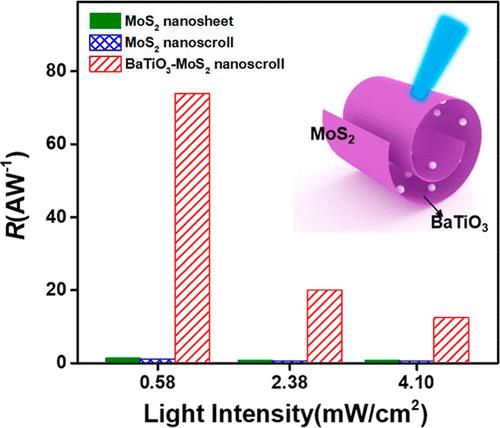当前位置:
X-MOL 学术
›
ACS Appl. Mater. Interfaces
›
论文详情
Our official English website, www.x-mol.net, welcomes your
feedback! (Note: you will need to create a separate account there.)
Enhancing Photodetection Ability of MoS2 Nanoscrolls via Interface Engineering
ACS Applied Materials & Interfaces ( IF 8.3 ) Pub Date : 2023-01-03 , DOI: 10.1021/acsami.2c18537 Jun Su 1, 2 , Xin Li 1, 2 , Minxuan Xu 1, 2 , Jian Zhang 2 , Xiaolian Liu 2 , Xin Zheng 1, 2 , Yueqin Shi 1, 2 , Qi Zhang 1, 2
ACS Applied Materials & Interfaces ( IF 8.3 ) Pub Date : 2023-01-03 , DOI: 10.1021/acsami.2c18537 Jun Su 1, 2 , Xin Li 1, 2 , Minxuan Xu 1, 2 , Jian Zhang 2 , Xiaolian Liu 2 , Xin Zheng 1, 2 , Yueqin Shi 1, 2 , Qi Zhang 1, 2
Affiliation

|
Van der Waals semiconductors have been really confirmed in two-dimensional (2D) layered systems beyond the traditional limits of lattice-matching requirements. The extension of this concept to the 1D atomic level may generate intriguing physical functionalities due to its non-covalent bonding surface. However, whether the curvature of the lattice in such rolled-up structures affects their optoelectronic features or the performance of devices established on them remains an open question. Here, MoS2-based nanoscrolls were obtained by virtue of an alkaline solution-assisted method and the 0D/1D (BaTiO3/MoS2) strategy to tune their optoelectronic properties and improve the light sensing performance was explored. The capillary force generated by a drop of NaHCO3 solution could drive the delamination of nanosheets from the underlying substrate and a spontaneous rolling-up process. The package of BaTiO3 particles in MoS2 nanoscrolls has been evident by TEM image, and the optical characterizations were mirrored via micro-Raman spectroscopy and photoluminescence. These bare MoS2 nanoscrolls reveal a reduced photoresponse compared to the plane structures due to the curvature of the lattice. However, such BaTiO3/MoS2 nanoscrolls exhibit a significantly improved photodetection (Rhybrid = 73.9 A/W vs Ronly = 1.1 A/W and R2D = 1.5 A/W at 470 nm, 0.58 mW·cm–2), potentially due to the carrier extraction/injection occurring between BaTiO3 and MoS2. This study thereby provides an insight into 1D van der Waals material community and demonstrates a general approach to fabricate high-performance 1D van der Waals optoelectronic devices.
中文翻译:

通过界面工程增强二硫化钼纳米卷的光电探测能力
范德瓦尔斯半导体在二维 (2D) 分层系统中得到了真正的证实,超越了晶格匹配要求的传统限制。由于其非共价键合表面,将这一概念扩展到一维原子水平可能会产生有趣的物理功能。然而,这种卷起结构中晶格的曲率是否会影响它们的光电特性或在其上建立的器件的性能仍然是一个悬而未决的问题。在此,借助碱性溶液辅助方法获得了基于MoS 2的纳米卷,并探索了 0D/1D (BaTiO 3 /MoS 2 ) 策略来调整其光电特性并提高光传感性能。一滴 NaHCO3 产生的毛细作用力3解决方案可以驱动纳米片从底层基板上分层和自发卷起过程。BaTiO 3颗粒在MoS 2纳米卷中的包裹已经通过TEM图像证明,并且通过显微拉曼光谱和光致发光反映了光学表征。由于晶格的曲率,与平面结构相比,这些裸露的 MoS 2纳米卷显示光响应降低。然而,这种 BaTiO 3 /MoS 2纳米卷表现出显着改进的光电检测(R混合= 73.9 A/W 对比R仅= 1.1 A/W 和R 2D= 1.5 A/W 在 470 nm,0.58 mW·cm –2 ),可能是由于 BaTiO 3和 MoS 2之间发生的载流子提取/注入。因此,本研究提供了对一维范德华力材料群落的深入了解,并展示了制造高性能一维范德华力光电器件的通用方法。
更新日期:2023-01-03
中文翻译:

通过界面工程增强二硫化钼纳米卷的光电探测能力
范德瓦尔斯半导体在二维 (2D) 分层系统中得到了真正的证实,超越了晶格匹配要求的传统限制。由于其非共价键合表面,将这一概念扩展到一维原子水平可能会产生有趣的物理功能。然而,这种卷起结构中晶格的曲率是否会影响它们的光电特性或在其上建立的器件的性能仍然是一个悬而未决的问题。在此,借助碱性溶液辅助方法获得了基于MoS 2的纳米卷,并探索了 0D/1D (BaTiO 3 /MoS 2 ) 策略来调整其光电特性并提高光传感性能。一滴 NaHCO3 产生的毛细作用力3解决方案可以驱动纳米片从底层基板上分层和自发卷起过程。BaTiO 3颗粒在MoS 2纳米卷中的包裹已经通过TEM图像证明,并且通过显微拉曼光谱和光致发光反映了光学表征。由于晶格的曲率,与平面结构相比,这些裸露的 MoS 2纳米卷显示光响应降低。然而,这种 BaTiO 3 /MoS 2纳米卷表现出显着改进的光电检测(R混合= 73.9 A/W 对比R仅= 1.1 A/W 和R 2D= 1.5 A/W 在 470 nm,0.58 mW·cm –2 ),可能是由于 BaTiO 3和 MoS 2之间发生的载流子提取/注入。因此,本研究提供了对一维范德华力材料群落的深入了解,并展示了制造高性能一维范德华力光电器件的通用方法。































 京公网安备 11010802027423号
京公网安备 11010802027423号